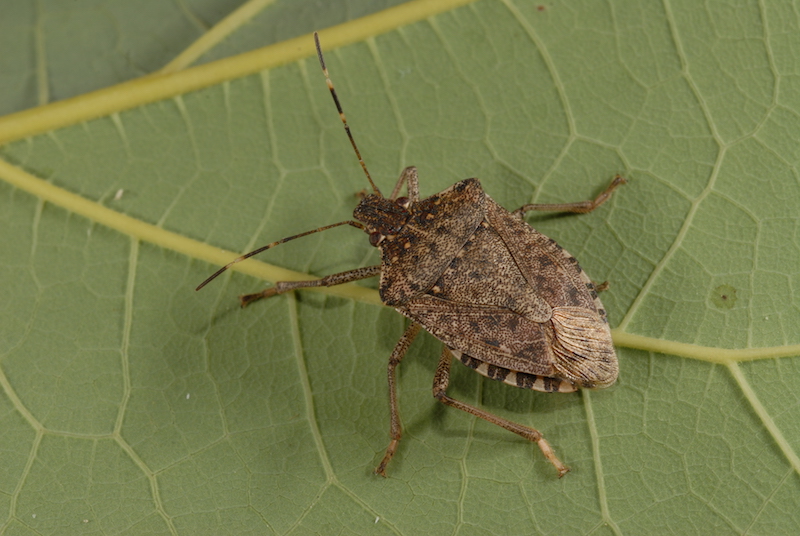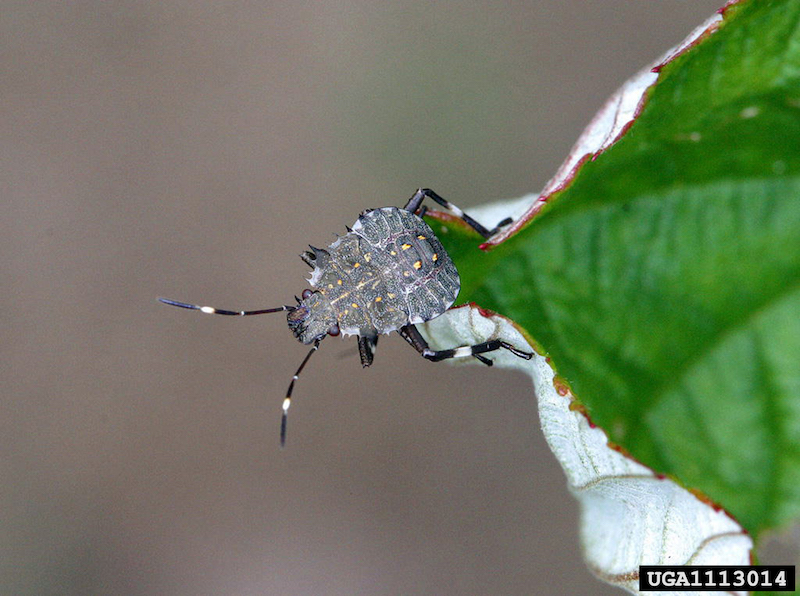In May of 2018 an egg clutch and nymphs of the brown marmorated stink bug (BMSB), Halyomorpha halys, was found in Lake County, Florida. Several weeks later an additional egg clutch with nymphs was found less than 1 mile from the previous detection. The Florida Department of Agriculture and Consumer Services, Division of Plant Industry has declared BMSB a regulatory significant pest of limited distribution in Florida, acknowledging that the Lake County population is the only known area where this pest is reproducing.

The brown marmorated stink bug is well known to residents of the Northern US. Following its detection in Pennsylvania in the early 2000’s, BMSB rapidly spread through most of the country, likely catching a ride on vehicles and cargo. In 2010 BMSB became known has a major agricultural pest after it wreaked havoc on apples, peaches and pears in the Mid-Atlantic, causing over $30 million in losses to growers. Pest problems are not limited to tree fruit, and BMSB has been reported to cause injury to tomatoes, sweet corn, soybeans, hazelnuts, almonds, and a range of other crops. Additionally, BMSB is a serious nuisance pest, seeking shelter in human dwellings during the fall and winter. Homeowners in areas with high BMSB populations may experience hundreds to thousands of BMSB entering their home in a given year.
To date BMSB is considered established in over 30 states but had not previously established in Florida. That was despite frequent interceptions of adults on vehicles entering the state. A survey of stink bugs in Florida peaches conducted by the Biosecurity Research and Extension Lab at UF detected low numbers of adult BMSB in 2016, 2017 and 2018, but follow up surveys did not find evidence that these bugs were reproducing in the area. It was speculated that Florida’s climate or lack of strong fluctuations in photoperiod (day length is used by BMSB to determine when to start and stop producing eggs) may be preventing BMSB from establishing in the state. The detection of a reproducing population of BMSB in Florida indicates that this pest may be capable of surviving in Florida.

The obvious question is, is there cause for concern? Fortunately for Florida the BMSB does not seem to be widespread in the state and has not been reported causing injury to crops outside of its limited area of establishment. At sites where BMSB has been detected only a handful of specimens have been found, suggesting the population is significantly lower than other parts of the country. Florida also benefits from the fact that BMSB is now well known and studied, which was not the case when it first wreaked havoc in the mid-Atlantic. Research on trapping, prevention and biological control has produced several effective tools for mitigating the impact of this pest.
The most important aspect in preventing BMSB from causing harm to Florida’s agriculture is monitoring its spread. If you believe you have encountered a BMSB you can send a sample to the insect ID lab at the University of Florida. Several other stink bugs look like BMSB, and a handy guide for telling them apart is available. In Florida most BMSB look-a-likes can be distinguished by their antennae; the BMSB has nearly-black antennae with white bands on the antennae (and light bands on the legs), while other similar brown stinkbugs have lighter antennae without such obvious banding. For more information on identifying and reporting other invasive agricultural pests in Florida, visit the Florida First Detector website.
 2
2
